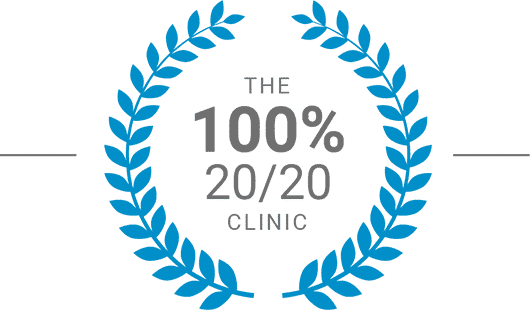Book Your Free Consultation
Mr David Allamby
MD, FRCOphth, FRCS
Refractive lens exchange (RLE) surgery can be life-changing for the correct candidates and improve short- and long-sightedness.
But as you consider undergoing this laser surgery, you may wonder what to expect after refractive lens exchange.
Thankfully, there’s a wealth of information to put your mind at ease and give you all you need to know about this procedure.
Refractive lens exchange (RLE) is a type of refractive lens replacement surgery or clear lens exchange (CLE). It involves removing the patient’s natural lens and implanting a synthetic one.
The implanted new lens is called an intraocular lens, or IOL for short.
It’s an excellent option for patients over 40 and can improve long-sightedness, short-sightedness, age-related near-vision loss, and astigmatism.
The surgery is relatively non-invasive, performed under drop anaesthesia and takes 15-20 minutes from start to finish.
Here’s what to expect immediately after it’s done and as you recover over time.
More information: Understanding the RLE Surgery Procedure
If you are considering lens replacement surgery, you are likely concerned about what your recovery could entail.
After RLE surgery, you can expect a quick recovery time and steady improvement in your vision. Full recovery can take between a week and several months. You may experience discomfort, blurriness, dry eyes, and some visual variation as your eyes and brain adjust to your new way of seeing.
Most of our patients experience a quick and painless recovery with minimal issues.
Although the surgery is quick, you may be at the hospital or surgical centre for around three to four hours.
Some final checks will need to be carried out before your procedure can go ahead, and you’ll have some time to relax in one of our recovery rooms for a short while after surgery so that we can ensure your recovery gets off to the best start possible.
You may find your vision surprisingly clear after the procedure, but even if this is the case, you will need someone to collect you from the clinic as you won’t be able to drive until signed off by the surgeon.
Immediately after your RLE surgery, your pupil will still be dilated from the procedure. It may remain that way for 24-48 hours, and you’ll likely experience a degree of blurred vision during this time.
You may also have a scratchy sensation inside your eye as the anaesthetising eye drops wear off and the pupil returns to its standard size, but you must resist the urge to rub or scratch your eye.
The surgeon will provide anti-inflammatory and antibiotic eye drops to help you avoid unnecessary discomfort and infection as you heal.
Your eyes will begin to heal immediately after your RLE surgery, but you may have fluctuations in your eyesight for a few weeks following the procedure.
Following your doctor's advice, you will likely be able to return to your usual activities within about a week. However, you should wait longer before swimming, immersing your eyes in water or engaging in contact sports.
The visual recovery for RLE patients is somewhat varied; however, the intraocular lens implant works well to correct vision problems for those with various prescriptions.
In many cases, patients notice an immediate improvement in their eyesight. The majority report an enormous improvement by the following day, and some note that it takes a few days before they become accustomed to their new lenses.
Typically, patients report a successful transition by their 1-week follow-up appointment with their eye doctor and are happily adapting to their new lenses.
For some patients, however, it can take weeks, months, or even a year to accept and integrate their synthetic lenses into their lives fully.
For those who receive premium multi-focal lens implants, the ability to read with ease quickly improves. If they had a strong prescription before the eye surgery, they might find it challenging to wait between lens exchanges.
Many patients opt to have both eyes treated with RLE on the same day.
Multi-focal lens replacements are fascinating and may take a little extra time for adjustment. Both near and far images are imprinted onto the retina simultaneously. It’s up to the brain to select the image it wishes to focus on, which is a new skill for the brain to interpret, so it can take some time to get used to.
Your vision may fluctuate as you progress through the healing after your RLE. Take it slowly and allow your brain and eyes to align and catch up with their new way of seeing and understanding your world.
You may also see halos and strobes of light for a few weeks as you heal, but these should disappear after about ten to twelve weeks.
As you return to work or spend time on the computer or outdoors, your eyes might become dry more often than usual. Use eye drops to keep them lubricated, and use them as instructed by your eye doctor.
When undergoing RLE, you must understand that you are learning to see in an entirely new way, which is a significant undertaking for your eyes and brain. Patience can be necessary.
The healing process after refractive lens exchange is typically quick and relatively pain-free.
Still, you can keep a few easy-to-follow tips in mind as you navigate your recovery. Make the most of your healing by staying safe and taking it easy as you adjust to your new lenses. Find out more about RLE safety and common complications.
Here are our 6 top tips for optimum healing after RLE:
The recovery after refractive lens surgery is typically quick and relatively pain-free.
Most patients notice a marked improvement in vision by the next day, but for some, it can take a week or two or longer.
Follow your eye doctor's instructions for optimum healing, and give your body and brain time to adjust to your vision improvements and your new way of seeing the world.
If you're considering lens replacement surgery, or you'd like to find out if you're suitable for another procedure, you can schedule a free telephone consultation with a member of our team here.
Book a FREE* Consultation
To get a better idea of how we can help you, and also the different types of services we offer, book a consultation now.

100% 20/20 vision
Focus Clinic has a remarkable 100% success rate for 20/20 vision. We know of no other clinic that has matched these results. There is a big difference between, for example, 98% and 100% success, especially if you are in the 2%.

10 year guarantee
Your 10 Year Guarantee means you can return at any time if you have additional questions on the quality of your vision. If you have distance vision correction for short-sight then any repeat laser eye treatments to correct a return of myopia in the first 10 years are included free of charge.*

Most trusted eye treatment clinic
We have the highest trust rating of any ‘eye treatment’ rated clinic, according to independent review site TrustPilot. With an outstanding 9.9 out of 10, when it comes to your eyes, choose the clinic that actual patients trust the most.
*Terms and conditions apply, excludes any age-related changes and conditions unrelated to the primary treatment